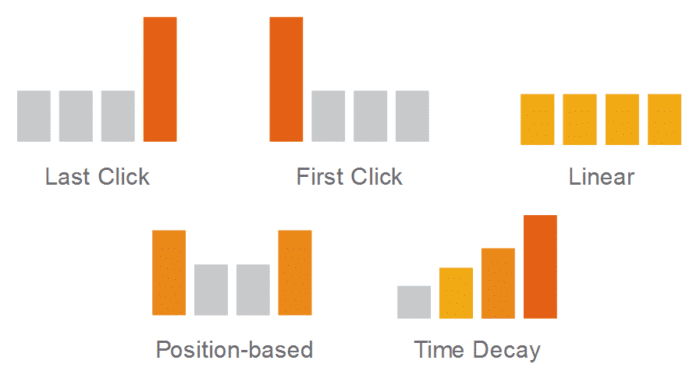A hungry Google user types ‘best salmon recipe’ into the search engine and lands on your recipe website. They cook up the salmon just as you said and they make this face when they eat it: 🤤
Two days later, they see an ad on Instagram to opt in and download your lead magnet with your 10 best seafood recipes. They do so.
Three days after that, you send them an email promotion for 25% off your cookbook. They visit the cookbook’s product page, but… they don’t buy it.
One day after that, they see a Google Search Ad for your cookbook, click on it, and this time they do buy it.
Which of those four marketing “touchpoints” should be credited with the sale?
Five Attribution Models
Data and analytics nerds (in which we include ourselves) have been rasslin’ with the “attribution problem” since long before the Internet was a thing. But the tracking capabilities of the web were supposed to make attributing credit so much easier and more reliable.
The truth is that attribution is still a tough nut to crack. Your trusty (and free) Google Analytics platform provides five attribution models to choose from:
Last Click: 100% of the credit is given to the last touchpoint. In our example, the Google Search Ad would be our hero.
First Click: We’re guessing you can figure this one out. In our example, our SEO team would get all the credit.
Linear: Each touchpoint gets equal credit. In our example, all four touchpoints would get 25% credit each.
Position Based: The first and last position each get 40% of the love and the remaining 20% is divvied up amongst any touchpoints in between. In our example, SEO and Google Ads will get 40% each while email and Insta ads would get 10% credit each.
Time Decay: With Time Decay (our personal favorite), the touchpoints closest to the sale get more credit than those further back in time. In our example, Google Ads would get the lion’s share of the attribution whilst SEO would get the least (which, for most cases, makes the most intuitive sense to us).
Based on keywords: Attribution modeling based on keywords is easily achievable with Google Ads. Thus, if you choose to serve ads through Google’s service, you will be able to easily apply attribution models to your campaigns without the need to integrate additional tools. However, an exception is made for interactions with display ads, which do not benefit from the default modeling possibilities.
What are the advantages of attribution models?
Many marketers focus on the last click or interaction with the customer when analyzing their campaigns. As a result, previously used channels and actions during the customer journey and their influence on conversions are often not sufficiently taken into account in the analysis. Attribution modeling offers an elegant way out of this view and has, among others, the following advantages:
- Attribution modeling provides a better understanding of the different stages of the customer journey than many traditional forms of analysis.
- Attribution models allow for the optimization of the entire customer journey, from the first to the last interaction.
- Attribution models cover the full range of possibilities for adjusting and automating campaigns.
- Allocation allows you to allocate your budget optimally for the long term and to invest primarily in the most profitable marketing channels.
- With multi-channel tracking, the modeling provides very accurate data and minimizes disruptive factors such as cookie dropping (third party cookies for affiliation).
